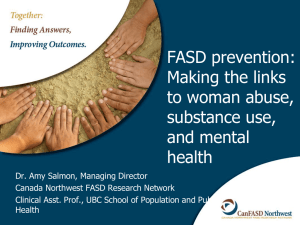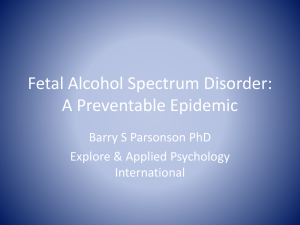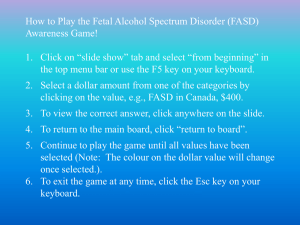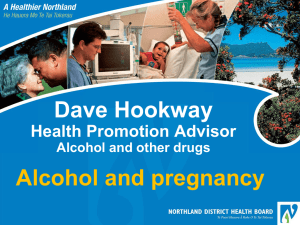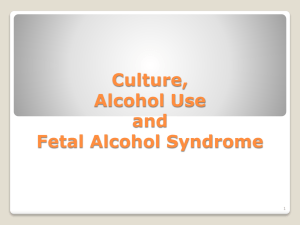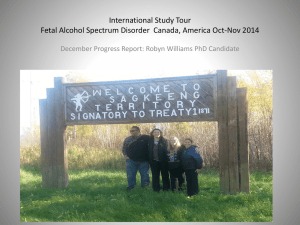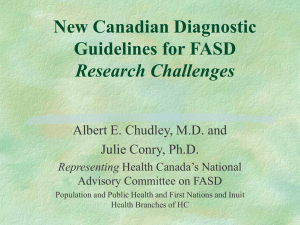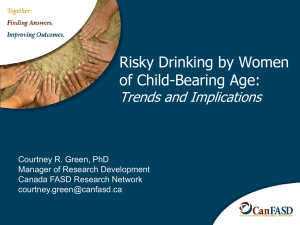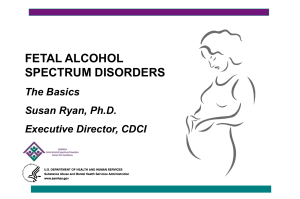FASD
advertisement
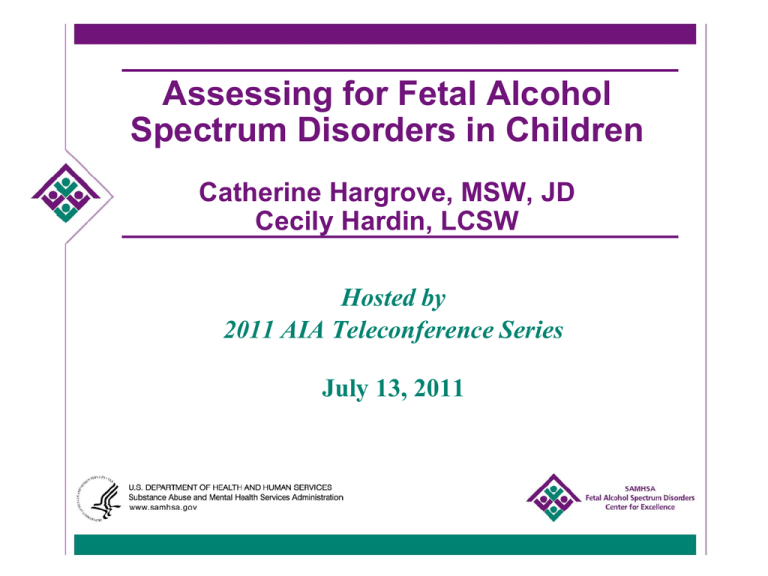
Assessing for Fetal Alcohol Spectrum Disorders in Children Catherine Hargrove, MSW, JD Cecily Hardin, LCSW Hosted by 2011 AIA Teleconference Series July 13, 2011 Case Study • 3 years 7 months old Caucasian male • Placed in foster care after his mother gave birth to a girl who had methamphetamines in her system • The Division of Children and Family Services conducted an investigation, and removed all children from the home • 3year old screened positive for an FASD using the NG screening tool • Mother admitted to using alcohol, marijuana, and methamphetamines during pregnancy • Mother states that she has a diagnosis of Bipolar disorder and completed the 10th grade in school Learning Objectives • To provide an overview of fetal alcohol spectrum disorders (FASD) • To learn about the SAMHSA FASD Center for Excellence diagnostic and intervention subcontracts • To apply screening criteria for FASD with children age 0-7 years, including positive monitoring (+monitor) • To share experience with the Child Guidance Center as a model for integrating FASD services into a behavioral health setting What Is FASD and Why Diagnose? Language of Fetal Alcohol Spectrum Disorders (FASD) • FASD is an umbrella term describing the range of effects that can occur in an individual whose mother drank alcohol during pregnancy. Although disorders within the spectrum can be diagnosed, the term FASD itself is not intended for use as a clinical diagnosis. Diagnostic terms under the FASD umbrella include the following: › › › › › › Fetal alcohol syndrome (FAS) Partial FAS(pFAS) Fetal alcohol effects (FAE) Alcohol-related neurodevelopmental disorder (ARND) Alcohol-related birth defects (ARBD) Prenatal alcohol exposure (PAE) What Are Fetal Alcohol Spectrum Disorders? • FASD are caused by prenatal alcohol exposure, resulting in birth defects and developmental disabilities. • Individuals with an FASD have a wide range of intellectual capabilities. • Disabilities due to prenatal alcohol exposure range from mild to severe. • How much alcohol will cause how much damage in an individual is not known. FASD—a Significant Challenge • FASD are the leading known preventable causes of mental retardation. • Prevalence of FAS in the United States is estimated to be 0.5-2 per 1,000 live births. • Prevalence of FAS, ARND, and ARBD combined is at least 10 per 1,000 or 1 percent of all births. • Based on estimated rates of FASD per live birth, nearly 40,000 infants born each year have an FASD. Why Diagnose FASD? • Confirms a disability based on brain impairment • Can help to improve outcomes with a targeted treatment plan • May qualify a child for accommodations in educational settings • Reframes behavioral problems and provides access to services Some Indicators of Need for Assessment • • • • • • • Positive result of screening for an FASD Small head, facial or dental abnormalities Joint, limb, and finger deformities Vision or hearing problems Heart or organ defects Sleeping, breathing, or feeding problems Maternal alcohol use 4 Key Diagnostic Features of FASD 1. 2. 3. 4. Prenatal alcohol exposure Characteristic facial anomalies Central nervous system abnormalities Growth deficiency Common Co-occurring Disorders • Attention-deficit/hyperactivity disorder • Bipolar disorder • Major depressive disorder • Oppositional defiant disorder • Antisocial personality disorder • Obsessive-compulsive disorder • Generalized anxiety disorder • Post-traumatic stress disorder • Disruptive behavior disorder Questions and Answers Initiatives of SAMHSA’s FASD Center for Excellence SAMHSA’s FASD Center for Excellence • A federal initiative devoted to preventing and treating FASD • Purpose is to decrease incidence of FASD and improve quality of life among persons with these disorders and their families • Seven subcontracts that focus on priority populations: children in child welfare and behavioral health systems Focus on Children Age 0-7 Years • Fetal alcohol spectrum disorders (FASD) are under-diagnosed. • Early diagnosis of an FASD and intervention can improve the lives of children and families. • Interventions developed on the basis of FASD diagnosis are apt to be most effective in meeting the needs of a child. Service Components • Screening for an FASD • Monitoring children age 0-3 years who have positive screening results for an FASD but are asymptomatic • Referring children with positive FASD screening results for diagnostic evaluation • Providing intervention services for children with diagnosis of an FASD FASD Screening • An FASD screening tool was developed by SAMHSA’s FASD Center for Excellence. • The tool was developed on the basis of the following sources: › Literature review › Expert panel input › Experience of previous subcontractors who used the tool Screening Criteria for Age 0-7 Years • Any one of the following: › Face rank 3 or 4, as measured by the facial photographic › › › screening tool for fetal alcohol syndrome Sibling with diagnosis of an FASD Child with previous FASD diagnosis Confirmed prenatal exposure to alcohol or drugs • Birth mother with confirmed history of drug or alcohol use outside pregnancy and any of the following characteristics in the infant: › Growth deficit › Central nervous system or developmental abnormality › Medical note of dysmorphia Case Study • • • • • • • • • • • • • • Premature African American female born prematurely tested positive for cocaine Chile Welfare report made Infant born with underdeveloped lungs and digestive track, therefore she remained in ICU Judge ordered child to remain in state’s custody Child received FASD screening, and received a Face Rank 3 Mother reported drinking gin daily for first month prior to knowledge of pregnancy After pregnancy confirmed, mother switched to a 6 pack of 12 oz. beers every other day, typically drinking at least 4 drinks each time she drank Child released from hospital after 4 months Placed in the +monitor status Mother’s parental rights terminated Child adopted in the fall of 2010 Genetics testing confirmed FAS diagnosis Interventions were provided consistent with the diagnosis Child is now 2 years old, still on oxygen and feeding tube, but doing fairly well Criteria for +Monitor Status • Confirmed prenatal exposure to alcohol or drugs but no › Current growth deficits › Central nervous system abnormalities or developmental delays › Medical note of dysmorphia +Monitor • Rationale › A child whose mother has a history of drug or › alcohol use is at risk for an FASD. Early diagnosis leads to early intervention, which can lessen the impact of long-term disabilities. FASD diagnostic resources are limited. › • Tracking › Every 3 months per subcontract standards › At any other times workers and family find › appropriate With routine reporting schedule FASD Service Integration • Integration supported by subcontract requirements • Coordination among multiple service providers • Shared case management *Handout with subcontractor descriptions Outcome Objectives of FASD Initiative • Outcomes from all subcontractors: › Placement stability in home setting › Improved school performance • Other outcomes from subcontractors: › Reduction of stress on caregivers › Placement stability in daycare or preschool facilities FASD Diagnostic Capacity • Ensure adequate diagnostic and monitoring capacity before deciding to perform screening for an FASD in children. • Do not allow demand for FASD screening to exceed diagnostic capacity. • Verify that the diagnostic center and team are willing to diagnose an FASD in a child age 0-3 years. • Know the FASD diagnostic criteria used. Questions and Answers Child Guidance Center, Inc. Jacksonville, Florida Model FASD Service Provider Case Study • R is a 7 year old Caucasian male who lives with his biological mother, her paramour and three siblings. • Mother reports that she drank before she knew that she was pregnant. • R was referred for home counseling because of a Child Welfare report due to environmental hazards and inadequate supervision. • Investigation revealed that R had been exposed to significant domestic violence during the first five years of his life. Child Guidance Center • 501 (c)(3) private not-for-profit organization • Accepts Medicaid as well as other insurances • Serves more than 5,600 children per year • Has mission to provide quality mental health and social services to children and their families, supported by the FASD Center project Services of Child Guidance Center • • • • • • • Outpatient counseling In-home and school-based counseling Mental health case management Psychiatric services Daycare consultation Child abuse prevention Supervised visitation FASD Integration Into Child Guidance Center • Consent for screening was incorporated into the parent orientation packet by the Child Guidance Center. • Policies and procedures were revised to include FASD services at all levels. • Children age 0-7 years receiving behavioral health services are referred for screening for an FASD with consent of the caregiver. Screening Process • FAS Facial Analysis Software and file review • Positive screening results: score of 3 or 4 on facial photographic analysis or score of 2 plus confirmation of prenatal alcohol exposure • Referral for diagnostic evaluation Diagnostic Team and Process • Networking diagnostic model • Diagnostic team includes the following: › Licensed clinical social worker › Psychologist › Speech and language therapist › Occupational therapist › Geneticist 22 Clinical Diagnostic Categories (4-digit code diagnostic criteria) • • • • • • • • Sentinel physical findings Static encephalopathy Neurobehavioral disorder Alcohol (exposed, not exposed, exposure unknown) Fetal alcohol syndrome (alcohol exposed) Fetal alcohol syndrome (alcohol exposure unknown) Partial fetal alcohol syndrome (alcohol exposed) Fetal alcohol syndrome phenocopy (no alcohol exposure) Availability of Diagnostic Services in Jacksonville • 35 percent of children served by the Child Guidance Center receive Medicaid. • Insurance (primarily Medicaid) is used to fund most aspects of the evaluation with referral from the primary care provider. › Medicaid is a State-based program. › Florida has 10 Medicaid health maintenance organization (HMO) pilot projects. • Part B and Part C providers for the Individuals with Disabilities Education Act (IDEA) also provide diagnostic services. Designing Interventions for Children With Diagnosis of an FASD • Children with FAS [or another…] FASD, have a degree of differences in their brains; it logically follows that they could benefit from what others with more obvious handicapping conditions are provided—ENVIRONMENTAL ADAPTATIONS. • Remove cognitive barriers: prevent those in cognitive wheelchairs from being asked to perform cognitive high jumps. › Diane Malbin Designing Interventions • Keep information concrete. • Determine whether poor behavior is a physically based unmet need or intentional misbehavior. • Be consistent. • Use repetition. • Establish stable routines. • Keep it short and sweet. • Be specific—say exactly what you mean. • Create structure. • Provide supervision. • Treatment planning should: › Develop a comprehensive report and recommendations. › Share the report and recommendations. › Adjust approaches and add services. Sensory Integration • Impacts › Concentration and organization › Academic learning ability › Capacity for abstract reasoning › Specialization of each side of the body and › › brain Self-esteem Self-control Normal vs. Disordered Sensory Integration Source: Dorothy Schwab What Works? • Traditional talk therapy is not helpful due to the language, memory, and attention problems typical of individuals with an FASD. • Psychotherapy with adaptations can be beneficial. • Creativity, persistence, and clinical intuition are essential. • Client-centered care is important. Focusing on concrete issues Dealing with the disabilities Supporting the person Taking a multidisciplinary approach Using family therapy Use role-playing. Use short sentences and concrete examples. Present information in multiple modes. Give simple step-by-step instructions; pictures are often helpful. Project Data • Screening, Diagnosis, and Intervention subcontract with Northrop Grumman during 2008-2012 • Results from November 1, 2008, through May 31, 2011: › 540 screenings › 59 positive screenings › 35 diagnostic evaluations › 31 children with diagnosis of an FASD Questions and Answers Keys to Developing Processes and Procedures for Assessing for FASD Keys to Developing FASD System of Care for Children • Incorporate FASD screening into existing service delivery systems. • Ensure diagnostic capacity. • Build on or establish a collaborative relationship with service delivery systems. • Increase knowledge and skills about FASD and screening skills. Integrate FASD Screening Into Existing Systems • Plan to avoid stand-alone programs, because they are difficult to sustain. • Build on existing collaborations and systems of care. • Perform screening for children in the population with high risk of alcohol exposure. Build Relationships With Service Delivery Systems • Develop monitoring capability or collaborate with an existing agency to provide and monitor services. • Engage caregivers in the monitoring process. • Determine how provision of services will benefit the service delivery agency or, if internal, the staff. • Build FASD diagnostic capacity › Ensure adequate diagnostic capacity to meet the › › screening demands. Verify that the diagnostic center and team are willing to work with children age 0-3 years to perform diagnosis. Include the diagnostic staff as critical partners on the team. FASD Awareness and Training • Build and expand FASD awareness to increase buy in of the agency and individual staff. • Train intake and assessment workers to screen for an FASD. • Change agency forms to include questions about prenatal alcohol exposure. Staff Training – Child Guidance Center • Provide formal and informal trainings that incorporate the following: › Occupational therapy › Social skills training › Parent support and education What We Hope To Learn • How to design interventions around the child’s strengths and abilities • How to achieve efficacy by introducing different components into treatment modalities Opportunities for Integration of FASD Services at Age 0-7 Years • Courts and child welfare systems—children who enter the foster care and adoption system • Compliance with the Child Abuse Prevention and Treatment Act beginning at birth • Home visiting programs for high-risk births • Children in programs such as mental health and Head Start SAMHSA FASD Center for Excellence Task Order Officer: Jon Dunbar-Cooper Project Director: Callie B. Gass 2101 Gaither Road, Suite 600 Rockville, MD 20850 1-866-STOPFAS (786-7327) http://www.fasdcenter.samhsa.gov/
